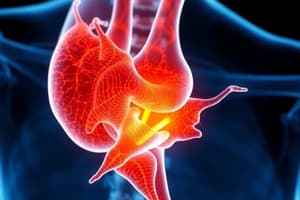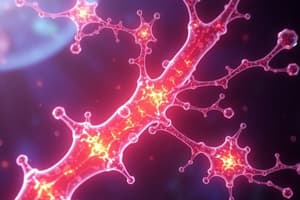Podcast
Questions and Answers
A postmenopausal client with osteoporosis is prescribed denosumab. What mechanism of action allows denosumab to treat osteoporosis?
A postmenopausal client with osteoporosis is prescribed denosumab. What mechanism of action allows denosumab to treat osteoporosis?
- Stimulating the release of parathyroid hormone, increasing bone turnover.
- Directly increasing calcium absorption in the small intestine.
- Inhibiting the production of osteoblasts, promoting bone formation.
- Binding to RANKL, which decreases osteoclast formation and activity. (correct)
A client receiving denosumab reports muscle cramps and tingling in their fingers. Which adverse effect should the nurse suspect?
A client receiving denosumab reports muscle cramps and tingling in their fingers. Which adverse effect should the nurse suspect?
- Osteonecrosis of the jaw
- Hypercalcemia
- Hypophosphatemia
- Hypocalcemia (correct)
A client with a history of chronic sinusitis is prescribed denosumab. What precaution is most important to consider before initiating therapy?
A client with a history of chronic sinusitis is prescribed denosumab. What precaution is most important to consider before initiating therapy?
- Screening for active infections. (correct)
- Checking complete blood count.
- Monitoring liver enzyme levels.
- Assessing kidney function tests.
A client is scheduled to receive a dose of denosumab. Which finding would cause the nurse to hold the medication?
A client is scheduled to receive a dose of denosumab. Which finding would cause the nurse to hold the medication?
A client is prescribed denosumab and also takes an immunosuppressant medication. The nurse should monitor for which potential drug interaction?
A client is prescribed denosumab and also takes an immunosuppressant medication. The nurse should monitor for which potential drug interaction?
A client prescribed denosumab is instructed to practice good oral hygiene and report any jaw pain or loose teeth. What is the rationale for this instruction?
A client prescribed denosumab is instructed to practice good oral hygiene and report any jaw pain or loose teeth. What is the rationale for this instruction?
When educating a client about denosumab, what should the nurse emphasize regarding lifestyle modifications?
When educating a client about denosumab, what should the nurse emphasize regarding lifestyle modifications?
Why is pregnancy testing required for clients who can become pregnant before starting denosumab therapy?
Why is pregnancy testing required for clients who can become pregnant before starting denosumab therapy?
Flashcards
Denosumab Mechanism
Denosumab Mechanism
Monoclonal antibody that binds to RANKL, reducing osteoclast formation and activity.
Denosumab Uses
Denosumab Uses
Osteoporosis in postmenopausal clients and men at high risk; fracture risk with glucocorticoid therapy.
Denosumab Adverse Effects
Denosumab Adverse Effects
Hypocalcemia, osteonecrosis of the jaw, atypical femur fractures, musculoskeletal pain.
Hypocalcemia & Denosumab
Hypocalcemia & Denosumab
Signup and view all the flashcards
Denosumab & Supplements
Denosumab & Supplements
Signup and view all the flashcards
Denosumab Administration
Denosumab Administration
Signup and view all the flashcards
Hypocalcemia Symptoms
Hypocalcemia Symptoms
Signup and view all the flashcards
Denosumab Contraindications
Denosumab Contraindications
Signup and view all the flashcards
Study Notes
Monoclonal Antibody Against RANKL – denosumab
Therapeutic Use
- Used for osteoporosis treatment in postmenopausal clients.
- Suitable for male clients at high risk for osteoporosis.
- Recommended for clients at increased risk for fractures or osteoporosis, especially those on long-term glucocorticoid therapy.
- Binds to receptor activator of nuclear factor kappa-B ligand (RANKL).
- Decreases the ability of osteocytes to produce and activate osteoclasts.
Adverse Drug Reactions
- May lead to hypocalcemia and osteonecrosis of the jaw.
- Can cause atypical femur fractures and musculoskeletal pain.
- Common adverse effects include upper respiratory infections, hypertension, headaches, and diarrhea.
Interventions
- Ensure any pre-existing hypocalcemia is resolved before starting.
- The client should take daily calcium and vitamin D supplements.
- It can potentially harm a fetus, pregnancy testing should be performed before therapy.
Administration
- Administer as a 60 mg subcutaneous injection every 6 months.
- Discard if the solution appears cloudy.
Client Instructions
- Clients should take supplemental calcium and vitamin D.
- Engage in weight-bearing exercises like walking.
- Maintain good oral hygiene and promptly report any jaw pain or loose teeth.
- Inform their dentist of denosumab use.
- Report signs of hypocalcemia, such as muscle cramps, numbness, or tingling.
Contraindications
- Contraindicated in clients with active infections.
Precautions
- Use caution in clients with chronic or serious infections.
- Adjusted for clients with severe kidney disease.
Interactions
- Immunosuppressant medications increase the risk for serious infections.
Studying That Suits You
Use AI to generate personalized quizzes and flashcards to suit your learning preferences.




